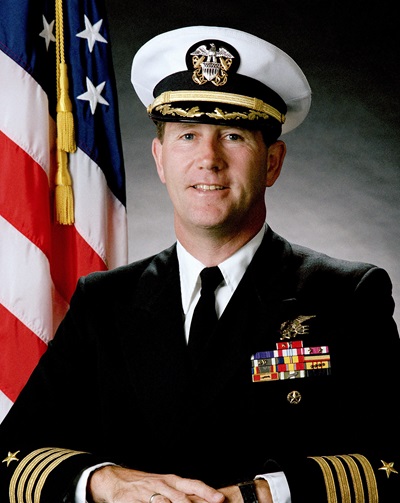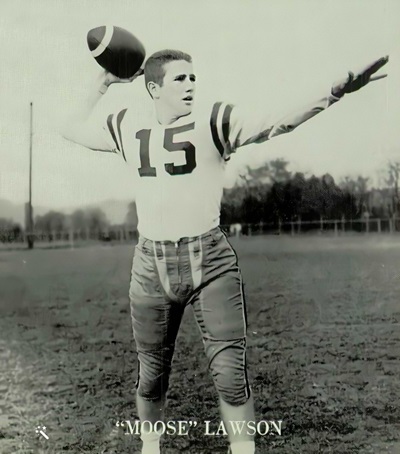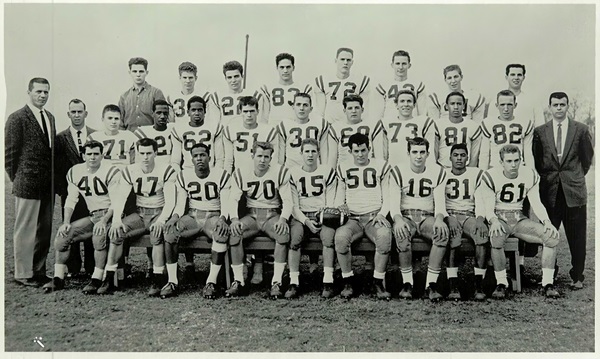The Lawson Call
The story you are about to read is true, to the best of our knowledge. But we share it here with some trepidation, as it may bring up an old controversy. However, we are also sharing it to invite discussion with our readers and to contemplate an ethical dilemma faced by a young man from Trafford several years ago.
The story is known only to a few, possibly due to the sensitive nature of a key individual’s past career after leaving Trafford. He became a prominent figure in the military Special Operations Forces community, and his profession, once masked in secrecy for the sake of National Security, is the reason we tread lightly here. However, in a new age of “right-to-know laws,” we feel comfortable sharing this story today.
We are talking about Thomas “Moose” Lawson (Trafford High Class of 1961), a former Navy SEAL Captain, and for his privacy, we are not revealing his current location, although we believe it to be somewhere in North America. Lawson was once a member of one of the most elite fighting forces assembled by our military.

The reputation of a Navy SEAL needs little explanation today for anyone familiar with their portrayal of Navy SEALs on the big screen. Movies like Captain Phillips (starring Tom Hanks), Zero Dark Thirty (the raid on Osama Bin Laden), or Lone Survivor (starring Mark Wahlberg) highlight the exceptional skills of this elite special operations force. Few people outside the SEAL community can even comprehend the intense training involved for which Lawson was responsible for two years, and yet, it was Lawson from Trafford who would ultimately rise to the second in command in this exclusive community, serving as Chief of Staff for the Naval Special Warfare Command.
We know that he did not reach that pinnacle without merit. From the National Archives records in Washington D.C., we learned that Lawson served on a Navy SEAL team during the Vietnam War, earning two Bronze Stars with Valor, the Purple Heart, two Navy Commendation Medals with valor, and several meritorious citations. His leadership experience likely made him an easy choice by the Department of Defense to place him in that top position. We also learned that he once served on staff at the U.S. Naval War College in Newport, RI, as well as the Joint Chief’s of Staff and Secretary of the Navy’s offices in Washington DC.
And so, through a protected source, we bring you a tale that played out on Saturday, October 15, 1960, in Trafford, PA. The Trafford High School football team was on the hunt for the Class B Title. They were riding on an undefeated season. During this Saturday game, Trafford was tied with the South Huntingdon football team 7-7. There were mere seconds remaining on the clock in the fourth quarter. The clock was ticking down, Trafford had the ball, and our source tells us that the players on the sideline were anxious, nervously watching the time tick away. Our protected source happened to be on the field as he watched this episode play out.
The Trafford offense had moved the ball all the way down the field to the one-yard line, but with no time outs remaining, the players were not getting to the line fast enough to call off another play. Coach Karanovich of Trafford was yelling at the top of his voice to hurry up, the crowd was screaming in desperation, and with this being the final down, spiking the ball to stop the clock was not an option.
As the seconds ticked off, a calm and collected Tom Lawson, the quarterback and one of the team captains understood the gravity of the situation. He knew if the clock ran out, it would end the game in a tie. He was also the Editor of the school newspaper (“The Tomahawk”) and it is believed he wasn’t about to sit down the next day to pen and article about how close the team came to having a perfect season. He needed something to happen quickly.
With little hesitation, this cool headed 17-year-old looked at the nearest player to him on the field and yelled, “Ronnie, you’re hurt! Get down.” Without pause, sophomore Ronald L. Nunn (Trafford High Class of 1963) heard the authoritative voice of his captain, witnessed the intense look in his eyes, and followed his quarterback’s command. Nunn immediately fell to the ground. An unwitting referee observed the helpless player struggling on the field and blew his whistle. The clock stopped leaving just 14 seconds on the clock. Nunn limped off the field while Lawson gathered his team together in the huddle to call the final play.
From the one-yard line, Lawson handed the ball to junior Marty Schneider (Trafford High Class of 1962) who followed a crushing block by Bill McHugh (Trafford High Class of 1961), and punched the ball across the goal line to cement Trafford’s win. The crowd went nuts. It was said that Ronnie Nunn could be seen jumping for joy on the sideline, the referee looking at him sideways, but that was it, a win in the books and the Tomahawks still holding on to an unbeaten record.

So here comes the age-old question: Was the decision made by this young quarterback an ethical decision? Players in the heat of competition are certainly faced with such ethical dilemmas all the time in sports. Did he make the right call? If there ever really was such a call made.
Apparently, among a select group of former players on the field that day, the so called incident has become known as the “Lawson call. “ Some may even deny it ever occurred. When we attempted to confirm the facts of the story with other players who were there, we approached one former player who was on the field at the time, Bob Nigrini (Trafford High Class of 1961). Bob would neither confirm nor deny the events as told here. When asked, Nigrini maintained a considerable grin on his face, a twinkle in his eye, but refused to answer our direct questions. All he could do was rub his elbow and deflect our questions by recalling the poor conditions of a field in those days.
The topic of a player being able to change the outcome of a game by bending or breaking the rules has filled hours of airtime on countless sports talk radio shows. A caller will inevitably complain to the host that “the call wasn’t fair,” or “the ref was definitely siding with the other team.”
But an even bigger question for former alumni of Trafford High, with this supposed new knowledge; does it call into question which team in Trafford High history was truly the greatest? Only three football teams at Trafford High had undefeated seasons. The 1949, 1960, and the 1968 football teams. Word of this new revelation is likely to provide fodder for the 1968 team who contend, with a chip on their shoulder, that they were the best. How would former players of the 1960 team now respond?

FIRST ROW: G. Smith, D. Surmacz, R. Nunn, R. Nigrini, Thomas “Moose” Lawson, T. Lovre, T. McHugh, B. Nunn, D. Allen. SECOND ROW: Mr. Karanovich, S. Rusilli, J. Brletic, C. Carter, L.. Culliver, H. Neil, M. Schneider, W. McHugh, E. Graffius, D. Culliver, R. Johnston, Mr. Cortazzo. THIRD ROW: J. Venturo, R. Yourcheck, M. Lebbano, R. Chiapetta, J. Sutmire, W. Smith, L. Simmons, V. Matulia.
The timing of this article was also intentional. As friends gather at the American Legion, or the Polish Club on the Wednesday before Thanksgiving, we know it’s better to leave the topic of politics at the door and spend time hashing out the real issues of days gone by.
We also believe this is an opportunity to take time to thank Tom Lawson for his 28-years of service to our country. Veterans Day may be over, but we can never express enough of our gratitude to all those young men and women currently serving our Nation who made the decision to raise their right hand and serve something bigger than themselves. We are grateful.
Happy Thanksgiving,
Andrew Capets



